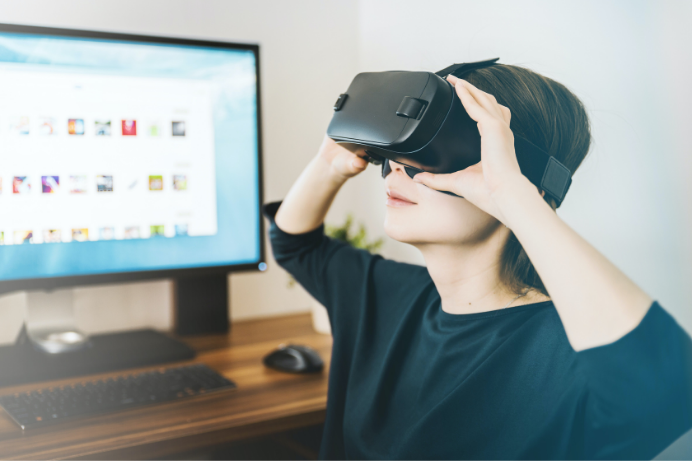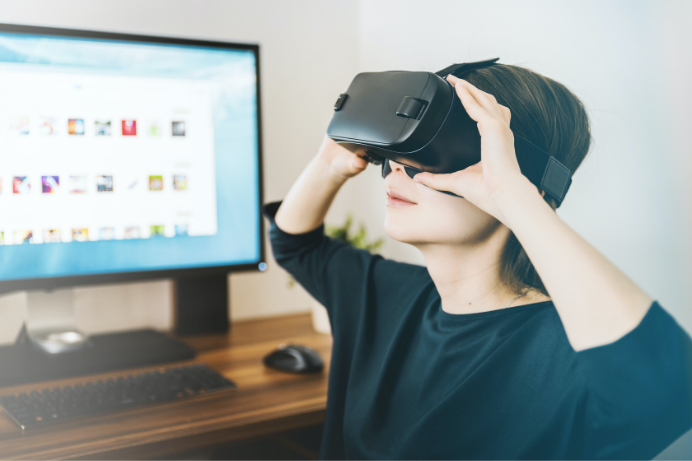
Developing VR software is not quite the same as creating a website or a mobile app. While two-dimension screens are familiar to everybody, the three-dimensional environments of VR are still a strange landscape where most users may not feel totally comfortable - at least at the beginning.
Learn more about our AR/VR development process, check out our new infographic.
While companies are increasingly investing in VR development, most of them are still struggling because of a lack of formative and evaluative research that can ensure training effectiveness, usability, comfort, and ROI. This is why VR User Testing is a critical workflow when developing a VR application. By applying UX knowledge to VR, cutting-edge VR testing programs conducted by experienced teams can help companies maximize their VR investment.
The four phases of a vanguard VR testing program
At Tonic3, we have developed a 4-step VR testing program for your company to be able to meet business goals. Let’s dive into it:
The process of VR Testing can be divided into four different phases:
1. Strategy and Research
First of all, you will need a team of VR experts that has learned everything about your business and is able to deeply grasp the needs and goals of your products. As any PM knows, this is essential in every UX oriented process, and the complexities of VR technology only emphasizes the importance of this familiarity.
Only VR experts with a thorough knowledge of your company can help you develop a strategy that will help you discover and explore the unique way in which your company’s goals and values can merge with the opportunities offered by virtual reality.
2. Definition of Goals and Test Scenarios
With a team capable of clearly defining the goals of the project, you will be ready to create the VR Test Scenarios that are aligned with your vision. Developing and testing VR applications demands and understanding of the complex interactions between all of the devices involved in the process. You should take into account that the majority of the equipment needed is very specific, such as VR headsets and controls.
Also, the team will need to have a deep understanding of the users’ profiles and a clear definition of the metrics that the test will observe.

3. VR User Testing
Consider that, for most users involved in the test, it may be their first encounter with a virtual reality environment, so effective communication is critical. Clearly explaining to users the tasks they will be performing and helping them prepare for the VR experience allows for the best possible results for VR testing.
During the test, the team should be detecting usability and learnability issues, while at the same time collecting biometric measures from the users. A cutting-edge VR testing program, performed remotely, will use a diverse set of technologies such as brain scanning, infrared scanning, and skin response. Video and audio recording will allow for a comparison between the different test scenarios.
4. Reporting and Recommendations
Once the test has been run, the team should classify all of the usability issues that may pop up. Also, considering what we’ve said before about how most participants will probably be entering a virtual environment for the first time, it is very important to be able to distinguish between the issues that arise from a lack of experience, and those that are due to the product itself.
With all of this in mind, we should be prepared to create a Recommendations Report, suggesting all the changes that will help you better meet your VR application’s goals. In the same way, looking at many dimensions of the virtual experience is a topic open for discussion in this step of the process.
Using this process, we will help you maximize your VR investment by ensuring the experience delivers on your business goals be it training, learning, delight, profit, etc.
An example of the innovative VR Testing processes that we, at Tonic3, perform.
How can your business benefit from VR?
As the immersive experience brought by VR applications is gradually becoming mainstream, the most innovative companies are making a great effort to leverage these new technologies.
The competitive advantages of VR software are somehow pretty easy to understand. While allowing companies to take customers and employees out of the real world and into a more stimulating virtual space where they can experiment, play and learn new skills, it’s helping them improve both customer engagement and internal training processes.
This is why it has become so important for companies to keep up with the immersive revolution: a future in which Extended Reality technologies will become an important part of the landscape of our everyday life may actually not be so far ahead.
If you'd like to discuss with one of our experts how to perform a VR Test that ensures your project meets its goals, you can reach us here and schedule an exploratory conversation - we’ll help you think through your goals. Our team has years of experience crafting rich user experience for virtual and augmented reality.
Learn more about our AR/VR development process, check out our new infographic.


